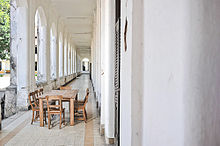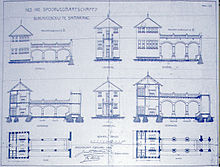Amazing Structure
Lawang Sewu
Lawang Sewu ("Thousand Doors") is a landmark in Semarang,Central Jawa, Indonesia, built as the headquarters of the Dutch East Indies Railway Company. The colonial era building is famous as a haunted house, though the Semarang city government has attempted to rebrand it.
ENTYMOLOGY & HISTORY
The name Lawang Sewu is from Javanese; it means "Thousand Doors". The name comes from its design, with numerous doors and arcs.The building has about 600 large windows.

Lawang Sewu was designed by Cosman Citroen, from the firm of J.F. Klinkhamer and B.J. Quendag. It was designed in New Indies Style, an academically-accepted term for Dutch Rationalism in the Indies.Similar with Dutch Rationalism, the style is the result of the attempt
to develop new solutions to integrate traditional precedents
(classicism) with new technological possibilities.
It can be described
as a transitional style between Traditionalists and the Modernists, and
was strongly influenced by the design of Berlage. Construction began in 1904 with A building, which was completed in 1907.The rest of the complex was finished in 1919. It was initially used by the Nederlandsch-Indische Spoorweg Maatschappij, the first railway company in the Dutch East Indies.
After the Japanese invaded Indonesia in 1942, the Japanese army took over Lawang Sewu.The basement of B building was turned into a prison, with several executions taking place there.When Semarang was retaken by the Dutch in the battle of Semarang in
October 1945, the Dutch forces used the tunnel leading into A building
to sneak into the city.A battle ensued, with numerous Indonesian fighters dying.Five employees working there were also killed.After the war, the Indonesian army took over the complex. It was later returned to the national railway company. In 1992 it was declared a Cultural Property of Indonesia.
URBAN LEGEND


Lawang Sewu is said to be haunted, with many tourists visiting to see the ghosts.Among the ghosts reported to inhabit the establishment are a Dutchwoman who committed suicide inside and "headless ghouls".
In 2007, a horror film entitled Lawang Sewu: Dendam Kuntilanak (Lawang Sewu: Kuntilanak's Vengeance) was released based on the legend. It told the story of a group of high school students from Jakarta
who were trapped in Lawang Sewu after several had to urinate and
featured ghosts of a Dutchwoman, a man with a ball and chain wrapped
around his leg, and a kuntilanak.
THE CONDITION RIGHT NOW

By 2009 the Lawang Sewu complex was in a state of considerable dilapidation. Simon Marcus Gower, writing in The Jakarta Post,
noted it as being "dark and evidently sick. Its white walls are faded
throughout; blackened by pollution and neglect. Rendered walls are
cracked and any wall paper has long since fallen away to reveal the red
bricks beneath. Mould and weeds grow over much of the building and mice
and rats are the chief residents.
The building soon underwent renovations to ensure that it would be profitable as a tourist attraction.Governor of Central Java Bibit Waluyo mobilized several dozen soldiers to assist with the renovations; the soldiers focused on external repairs.Local residents were disappointed in the renovations, opining that it had lost its authenticity.
On 5 July 2011 the newly renovated complex was inaugurated by First Lady
Ani Yudhoyono.However, at the time only B building was available for tours. It is hoped to be a main attraction in the Central Javan government's tourism program in 2013.
Future plans include transforming Building B into office space, a food court, and even a gym.
In late 2013 the Semarang city government announced plans to eliminate
the building's "spooky image" in order to attract more visitors. This
was to encompass a reimagining of the site as a place for social and
cultural activities, supported by renovations of the building. At the
time, Lawang Sewu attracted an average of 1,000 visitors daily.
Why I like this place is because we can see from the structure, that the detail is so beautiful. Beside the horror story we can that Lawang Sewu is a beautiful building.
Question
- Who built the 'Lawang Sewu' building ?
- Why 'Lawang Sewu' became a famous building ?
- What is the function of 'Lawang Sewu' building in colonial era ?
- What is the future plan for 'Lawang Sewu' building ?
- Who designed the 'Lawang Sewu' building ?





Comments
Post a Comment